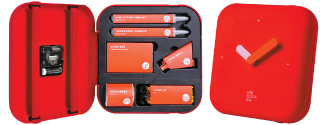Designing a clock that can save your life

The Life Clock hit the market in August. The clock doubles as a disaster preparedness kit consisting of five products necessary for survival in a crisis. [KOREA GYEONGGIDO COMPANY]
The clock doubles as a disaster preparedness product: It is composed of five basic relief goods including an emergency portable light, an emergency rescue whistle, an SOS emergency flag, an emergency thermal blanket for warmth and protection from the weather, and a roll of compressed gauze to treat bleeding and fractures.
The Life Clock was created by the Korea Gyeonggido Company in August, and its sales jumped after an earthquake hit the southeastern city of Pohang on Nov. 15. The company has sold over 10,000 of the clocks in less than four months after its release.
Kim Euna, the company’s CEO, explained that she saw a need for a friendlier version of a product that is associated with emergencies. “I thought that although heavy disaster safety kits already exist in the market, there still was a need for a lighter safety kit which is eye-catching and can be grabbed immediately when a disaster occurs,” she said.
Korea Gyeonggido Company is the result of joint investment between Gyeonggi province and a number of regional economic organizations. They work together to find small-and mid-sized enterprises that make high-quality products and technologies but lack in design and marketing, and ultimately help those enterprises in planning, production and advertisement. The company also independently plans out their own products.
The development process for the Life Clock was not as simple as its components. They sought out advice from not only disaster safety experts but also from firefighters, developers of other disaster preparedness products, doctors and more, taking seven to eight months to finish the clock.
“We had to think carefully about which products to take out rather than adding more,” Kim said. “The survival bags already on the market weigh more than 5 kilograms [11 pounds] on average, so it’s difficult for children or senior citizens to carry around. Also, these bags have traditionally been expensive, so we decided to create a product that is lighter, more practical and cheaper.”
They chose the contents after much discussion with the experts. They chose to put in the thermal blanket for the old, weak and the injured, as staying warm is crucial for their survival, especially during an emergency situation.
The developers of the product also included a signal flag and a whistle, which both can be used in case of a building collapse, a common concern of the many people who live in tall apartments throughout the country.
They also added a portable light which can last for up to 12 hours and compressed gauze for emergency medical treatment. All of the clock’s components can be used multiple times. The Life Clock weighs 1.07 kg, light enough to carry around in case of the disaster. A photo manual is also included so that children and seniors can easily understand and use everything inside the kit. The clock’s price is relatively lower, too - 39,000 won ($35.94), which is over two times cheaper than other survival bags, which usually cost more than 100,000 won.
Pyeongchang Winter Olympics medal designer and CEO of SWNA Design Studio Lee Suk-woo participated in designing the product, and it was his suggestion that it should be shaped like a clock - an item easily found in most homes. A total of 18 SMEs collaborated to make the contents of the kit. Kim plans to actively develop more kits to be used in various disaster emergency situations in collaboration with other domestic SMEs.
BY CHOI MO-RAN [ lee.jaelim@joongang.co.kr]
재난용품 시계에 담았다 … 경기도가 만든 ‘반값 키트’ 인기
가로·세로 21㎝에 4.5㎝ 높이. 겉모습은 영락없는 시계다. 커버를 열고 건전지를 넣자 ‘똑딱똑딱’ 시침과 분침이 움직인다. 인테리어용 벽걸이 시계로도 손색이 없어 보인다. 하지만 내부는 다르다.
시야 확보와 구조 요청에 도움을 주는 조명봉과 체온을 유지하도록 도와주는 보온포, 구조 요청과 위치를 알리는 호루라기·깃발, 응급처치를 위한 압박붕대가 들어 있다. 경기도주식회사가 지난 8월 선보인 재난 안전키트인 ‘라이프 클락’이다. 경북 포항 지진 이후 판매량이 급증하면서 출시 4개월도 안 돼 1만 개가 팔렸다.
김은아(44·여) 경기도주식회사 대표는 “무겁고 구석에 방치하는 재난 안전용품이 아닌, 눈에 보이는 곳에 두고 재난 시 바로 가지고 나올 수 있는 재난 안전용품이 필요하다는 생각에 ‘라이프 클락’을 만들었다”고 설명했다.
경기도주식회사는 경기도와 지역 경제단체들이 출자해 만든 회사다. 제품과 기술력은 뛰어나지만 디자인과 마케팅 능력이 떨어지는 중소기업을 발굴해 제품 기획·생산·홍보 등을 도와준다. ‘라이프 클락’처럼 독자적으로 제품을 기획하기도 한다. 개발 과정은 쉽지 않았다. 재해·재난 안전 전문가는 물론 소방, 재난 용품 개발자, 의사 등 10여 명의 전문가를 만나 자문을 구하고 제작하는 데 7~8개월이 걸렸다. 전문가들이 제안한 물품을 모두 담으려면 부피가 커질 수밖에 없었다. 김 대표는 “당시 ‘어떤 것을 추가할까’가 아니라 ‘빼야 할지’를 고민했다”며 “재난 대비용으로 많이 알려진 생존(재난)가방은 평균 무게가 5㎏ 이상이라 어린이나 노인들이 사용하기엔 불편하고 가격도 비싸기 때문에 가볍고 실용적이면서 저렴한 제품을 만들기로 했다”고 말했다.
전문가들과 상의해 물품을 골랐다. 체온 유지가 중요한 노약자와 부상을 당한 환자 등을 위해 보온포를 넣고 아파트 거주 비율이 높은 국내 상황을 반영해 구조 깃발도 만들었다.
12시간 빛나는 조명봉과 응급치료를 위한 압박붕대 등도 포함했다. 모두 일회용품이 아닌 여러 번 사용이 가능하다. 특히 1.07㎏으로 가벼워 재난 시 쉽게 들고나올 수 있다. 아이들이나 노약자도 쉽게 사용할 수 있도록 사진 매뉴얼도 만들었다. 김 대표는 “대체할 수 있는 물품은 과감하게 버렸다”고 말했다. 그래서 가격도 기존 생존배낭(10만원 이상)의 절반 이하 가격(3만9000원)으로 책정할 수 있었다고 한다.
평창 겨울올림픽 메달을 디자인한 이석우 SWNA 대표가 디자인에 참여했다. 집에 모셔두는 재난키트가 아닌 자주 보는 ‘시계’ 모양으로 만들자고 제안해 반영했다. 도내 18개 중소 제조업체가 보온포 등을 만들었다. 김 대표는 “도내 중소기업들과 협력해 재난 상황별 키트 개발에도 나설 계획”이라고 말했다.
글 최모란 기자










with the Korea JoongAng Daily
To write comments, please log in to one of the accounts.
Standards Board Policy (0/250자)